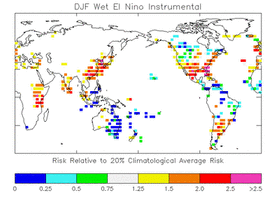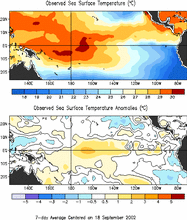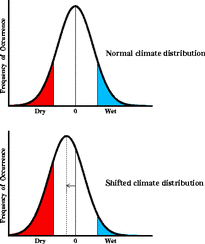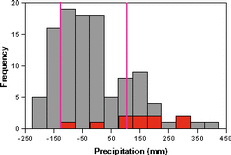
| Global Patterns of the Risk of Seasonal Extremes Related to ENSORobert S. Webb, Jon K. Eischeid, Henry F. Diaz, Klaus E. Wolter, Catherine A. Smith, and Randall M. Dole |
 |
 |
| Figure 1. Most recent weekly SSTs and anomalies from NOAA/CPC ENSO Advisory. |
Background
The emerging El Niño conditions in the equatorial Pacific [Figure 1] lends itself to the question of how and what will be the spatial and temporal signature of climate impacts from the anticipated changes in the sea surface temperatures in the coming months.
Many expectations for upcoming climate extremes and weather events over the 2002 Fall to 2003 Winter and Spring are based on the current memory of the 1997-98 El Niño and other recent El Niños. Alternatively, numerous rigorous studies [e.g., Ropelewski and Halpert, 1987; Kiladis and Diaz, 1989] and WWW based compilations and interpretive composite maps have provided global to regional assessments of the average changes in precipitation and temperature associated with El Niños and La Niñas. Unfortunately the development of an objective seasonal prediction system for the global patterns of temperature and precipitation extremes under the potential of evolving El Niño conditions remains an ongoing research task. In lieu of such a prediction capability, we use the instrumental record to make quantitative assessment of global patterns of the risk of ENSO related seasonal climate extremes [often defined as the upper and lower 20th percentiles of the climatological range]. In the following study we have followed the Wolter et al. [1999] approach developed to characterize the risk of climate [temperature and precipitation] extremes associated with El Niños and La Niñas for the coterminous United States. We expand on and slightly modify the Wolter et al [1999] approach to make a assessment of the global patterns of the risk of seasonal temperature and precipitation extremes related to El Niño and La Niña.
Extreme climate conditions strongly impact [both positively and negatively] the natural environment and society [Mearns et al., 1984] highlighted the potential large sensitivity of extreme events to relatively small changes in the mean conditions under climate change. The natural environment and society have been, and will continue to be, strongly impacted by extreme climate events associated with ENSO variability. Our climate extremes focus is based on the recognition that minor changes in the mean can result in rather significant change in the tails of a population distribution. For example, a mean climate shift equal to a 1/2 standard deviation decrease will double the likelihood of dry[cold] extreme events expected under normal conditions while halving the likelihood of wet[warm] extreme events expected under normal conditions (Figure 2). Likewise, a mean climate shift equal to 1/2 standard deviation increase would double the likelihood of wet[warm] while halving the likelihood of dry[cold] extreme events expected under normal conditions.
 |
Figure 2. The difference between the two panels illustrates an idealized mean climate shift for a normally distributed population of climate data and shows the amplified impact on the tails of the population distribution [e.g. climate extremes]. It is worth noting that many climate data [especially precipitation data] are very often not normally (not Gaussian) distributed and thus the increase/decrease in likelihood of extreme conditions associated with shifts in the mean will deviate from the idealized case shown. |
Data and Methods
To generate that global maps of the risk of seasonal temperature and precipitation extremes related to El Niño and La Niña, we used temperature and precipitation data from close to 8000 terrestrial stations with data spanning 1890 to 2000 [Vose et al., 1992]. The monthly station data were converted into 3-month seasonal anomalies and then gridded to the NCAR PaleoCSM atmosphere 3.75°x°3.75 grid [48 latitudinal and 96 longitudinal grids] for each of the twelve 3-month seasonal averages [Jan-Feb-Mar, FMA, ......, DJF].
The existence of El Niño and La Niña conditions for the risk analyses were determined using the monthly Bivariate ENSO Timeseries ['BEST' Index ; Smith, C.A. and P. Sardeshmukh, 2000]. Given the persistence of sea surface temperatures and the lagged impact on the atmosphere and resulting climate conditions in the 110 year climate record analyzed, if the lead month of the three month seasonal average was determined using the BEST index to be either an El Niño or La Niña then within the risk analysis the season was considered to be associated with an El Niño or La Niña.
To define ENSO climate extremes, analyses were made at each grid box for each of twelve 3-month seasonal averages if data existed for a least 82 [75%] of the 110 years record. The 20 and 80 percentile values for each of the 3-month seasonal averages were used to define the climatological extreme threshold. The risk associated with El Niño or La Niña was calculated as the ratio of the 20 percent expected for a given month for both tails of the distribution versus the actual number of years for each 3-month seasonal average that exceeded the 20 and 80 percentile climatological extreme threshold.
For example, in the 109 year record of seasonal NDJ precipitation along the east coast of Australia, 9 of the 11 years classified as La Niñas, were in the upper 20 percent of the dataset (Figure 3). Since by chance one would expect only two of the La Niña years to be extreme (11 years multiplied by 0.2) then the change in risk was 4.5 (9 La Niña extreme years divided by the 2 expected extreme years).

|
Figure 3. Histogram showing the distribution of seasonal NDJ precipitation in the east coast of Australia for 109 climatology years (grey) and for the subset of 11 La Niña years (red). The two vertical lines demark 20 and 80 percentiles of the climatological range. |
We used a boot-strap resampling with replacement test for significance with a sample size of 10,000 and only included results that were significant at >95% confidence interval in the global maps of the risk of seasonal temperature and precipitation extremes related to El Niño and La Niña.
Results
The resulting global patterns of Seasonal Precipitation and Temperature Extremes Related to El Niño and La Niña can be accessed below. Note that in many places there is not always a symmetric response in increase or decrease risk for wet/warm or dry/cold extremes under El Niño or under La Niña conditions. Likewise in many places there is not always a symmetric response in increase or decrease risk for wet/warm or dry/cold extremes between El Niño and La Niña conditions.
- Global Patterns of the Risk of Seasonal Precipitation Extremes Related to ENSO
- Global Patterns of the Risk of Seasonal Temperature Extremes Related to ENSO
To illustrate how a change in risk associated with El Niño or La Niña relates to shifts in the mean and extreme temperature and precipitation values, we selected a subset of cases with exceptional increases in the risk for extreme conditions. For these cases we generated empirical probability density functions [PDFs] for the complete temperature or precipitation records [all years] and for the subset of years under El Niño or La Niña conditions. In many cases the shift [increase/decrease] in the risk of climate extremes is associated with large shifts in mean climate [e.g., the east coast of Australia]; however in some cases [e.g., along the Pacific coast of South America] significant increases or decreases in the risk of climate extremes can occur with only minor changes in the mean value. Figures illustrating differences in the tail of the probabilities [extremes] associated with El Niño and La Niña years can be accessed below.
- Examples of extreme El Niño and La Niña related shifts in precipitation anomaly PDFs relative to Climatological PDFs
- Examples of extreme El Niño and La Niña related shifts in temperature anomaly PDFs relative to Climatological PDFs
Concluding Remarks
Although past performance is no guarantee of future performance, an examination of the instrumental record of the risk for seasonal temperature and precipitation climate extremes associated El Niños and La Niñas can provide insights into the range of possible future climate impacts. Extreme climate conditions associated with El Niños and La Niñas have and will continue to strongly impact the natural environment and society. The results presented in this study provide an objective quantitative assessment of global patterns of the risk of ENSO-related seasonal climate extremes. The maps showing the global patterns of the risk of seasonal precipitation and temperature extremes related to ENSO can be interpreted to provide guidance in terms of where one might expect an increased or decreased risk of flooding, drought, heatwave, or coldwave under El Niño and La Niña conditions; however, these associations should not be misinterpreted as deterministic. As illustrated in the empirical probability density function analyses, in almost all cases the increases in risk of extreme wet/warm climate conditions do not exclude the possibility of extreme dry/cold or mean climate conditions. In other words, an increase or decrease in risk of climate extremes does not preclude the opposite from happening, just that the probability of the opposite occurring is significantly reduced.
- References:
-
Kiladis, G. N., and H. F. Diaz, (1989). Global climate anomalies associated with extremes in the Southern Oscillation. J. Climate, 2, 1069-1090.
Mearns, L. O., R. W. Katz, and S. H. Schneider (1984). Extreme high-temperature events: Changes in their probabilities with changes in mean temperatures. J. Climate Appl. Meteor., 23, 1601-1613.
Ropelewski, C. F. and Halpert, M. S. (1987). Global and regional scale precipitation patterns associated with the El Niño/ Southern Oscillation (ENSO). Monthly Weather Review, 115: 1606-1626
Smith, C.A. and P. Sardeshmukh (2000). The Effect of ENSO on the Intraseasonal Variance of Surface Temperature in Winter., International J. of Climatology, 20, 1543-1557.
Vose, R. S., R. L. Schmoyer, P. M. Steurer, T. C. Peterson, R. Heim, T. R. Karl, and J. K. Eischeid. 1992. The Global Historical Climatology Network: Long-term monthly temperature, precipitation, sea level pressure, and station pressure data. NDP-041. Carbon Dioxide Information Analysis Center, Oak Ridge National Laboratory, Oak Ridge, Tennessee.
Wolter, K., R. M. Dole, and C. A. Smith, 1999: Short-Term Climate Extremes over the Continental United States and ENSO. Part I: Seasonal Temperatures. J. Climate, 12, 3255-3272.